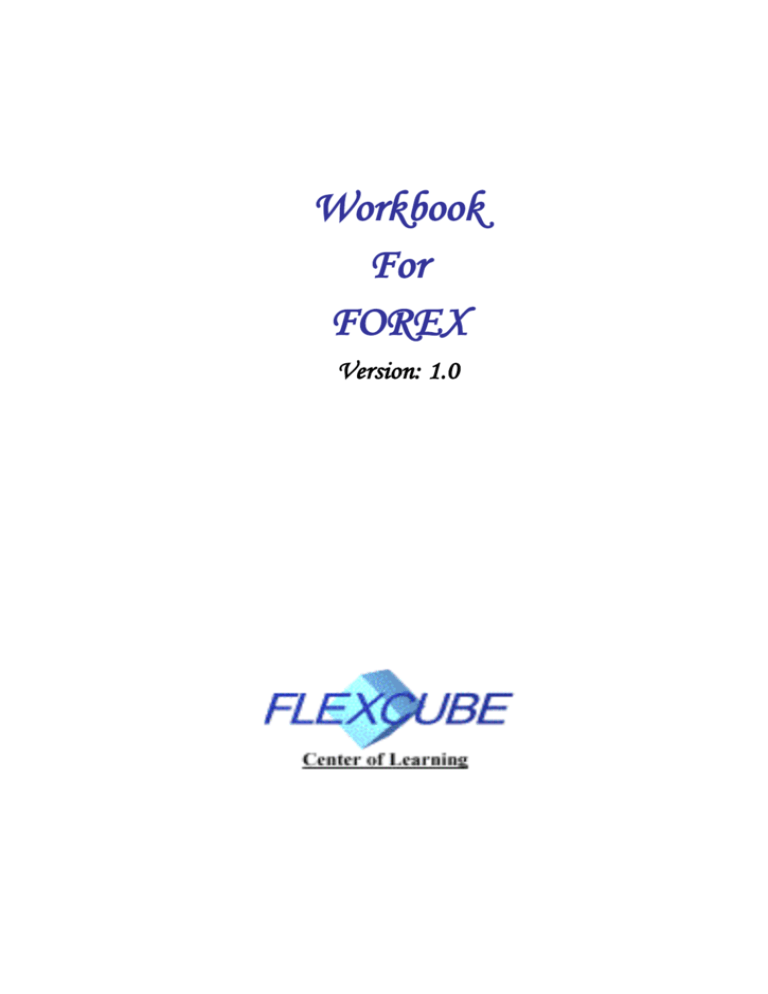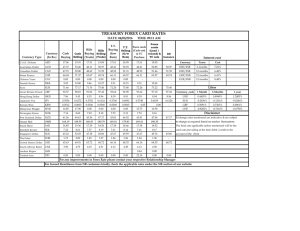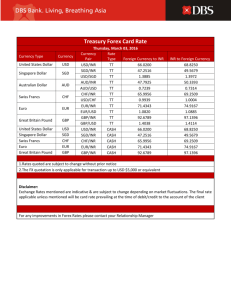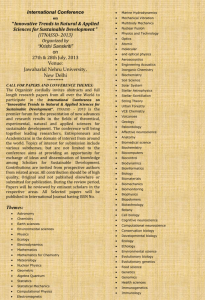
Workbook
For
FOREX
Version: 1.0
© 2001 by i-flex solutions limited
All rights reserved. No part of this work may be reproduced, stored in a retrieval system,
adopted or transmitted in any form or by any means, electronic, mechanical,
photographic, graphic, optic recording or otherwise, translated in any language or
computer language, without the prior written permission of i-flex solutions limited (iflex).
Due care has been taken to make this workbook as accurate as possible. However, i-flex
makes no representation or warranties with respect to the contents hereof and shall not be
responsible for any loss or damage caused to the user by the direct or indirect use of this
workbook. Furthermore, i-flex reserves the right to alter, modify or otherwise change in
any manner the content hereof, without obligation of i-flex to notify any person of such
revision or changes.
All company and product names are trademarks of the respective companies with which
they are associated.
File Name
Creation Date: 21st August 2002
Review Date: 15th Jan 2003
Last Saved On: 15th Jan 2003
Workbook Forex
By : K Sridhar
By : S Shankar
Group: FC-COL Banking Products Group
Workbook – Foreign Exchange
3
Table of Contents
Foreign Exchange
1. Concepts used in FX contracts
1.1 Exchange rate
1.2 Buy, sell and mid rates
1.3 Buy and sell spread
1.4 Exchange rate types
1.5 Quotation method
1.6 Number of units
1.7 Discount Rate
1.8 Through currency
1.9 Cash, Tom, Spot, and Forward contracts
1.10 Forward rates
1.11 Arbitrage
1.12 Market maker
1.13 Premium/discount
1.14 Interest parity principle
1.15 Cancellation of forward contracts
1.16 Extension of forward contracts
1.17 Swaps
1.19 Split Value Dates
1.20 Revaluation
1.21 Netting
2. Features Of Foreign Exchange Module In FLEXCUBE
4
5
5
5
5
6
7
7
7
7
8
9
9
9
9
10
10
11
11
11
12
22
22
Workbook – Foreign Exchange
4
Foreign Exchange
Banks offer a wide range of services to their customers. One of the services is to buy and
sell various foreign currencies to meet the customer’s requirements. Every FOREX
transaction involves exchange of two currencies by the counter-parties of the transaction.
One party, for instance, receives Dollars in New York and pays out Rupees in Mumbai.
The counter-party pays out Dollars in New York and receives Rupees in Mumbai.
The requirement to exchange currencies arises on account of a variety of transactions:
● An importer in India buying goods from England by paying GBP to the supplier,
● A company, earning foreign currency, wanting to hedge against exchange rate
movements
● Banks wanting to exchange currencies to meet the requirements of their clients
● A speculative customer hoping to profit from the movement of exchange rate
between USD-INR
● A customer wanting to take advantage of the price disparities amongst various
foreign currency markets
Workbook – Foreign Exchange
1.
Concepts used in FX contracts
1.1
Exchange rate
5
Exchange rate is the number of units of one currency (say Currency1) that would be
exchanged for a specified amount of another currency (say Currency2). To illustrate, if 30
Indian Rupees are exchanged for 1 US Dollar, the exchange rate between USD and INR
is 30.
1.2
Buy, sell and mid rates
A bank would be involved in both buying and selling foreign currencies. It makes a profit
by selling foreign currencies at a higher rate as compared to rate at which it buys foreign
currencies. The exchange rate at which the bank is willing to buy a foreign currency is
called ‘buy’ rate, while the exchange rate at which it is willing to sell a foreign currency
is called the ‘sell’ rate. ‘Mid’ rate for a foreign currency is the rate at which the bank will
not make a profit or loss in buying or selling.
1.3
Buy and sell spread
The difference between the mid rate and buy rate is called ‘buy’ spread and the difference
between the sell rate and mid rate is called the sell spread. A buy/sell spread represents
the indicative profit margin of a foreign exchange deal.
The spread for a specified currency pair could be defined in two conventions - in points
and in percentages.
In points, the buy rate and sell rate would be calculated as:
Buy rate = Mid rate - spread x points multiplier
Sell rate = Mid rate + spread x points multiplier
In percentages, the buy rate and sell rate would be calculated as:
Buy rate = Mid rate - spread x mid rate / 100
Sell rate = Mid rate + spread x mid rate / 100
(spread will be subtracted if the FCY is quoted at a premium and will be added if the FCY
is at a discount)
Workbook – Foreign Exchange
6
The effective spread can therefore be calculated using the following formulae:
In points, effective spread = spread x points multiplier
In percentage, effective spread = spread x mid rate / 100
The most commonly used convention in defining spread is the points multiplier method.
To illustrate, consider two cases.
Case 1
Suppose for the currency pair USD - DEM the mid rate is 1.6040, the buy and sell
spreads are 10 points each and the points multiplier is 0.0001. The buy and sell rates
would be calculated as
Buy rate = 1.6040 - 10 x 0.0001 = 1.6030
Sell rate = 1.6040 + 10 x 0.0001 = 1.6050
Case 2
Suppose for the currency pair USD - DEM the mid rate is 1.6040, the buy and sell
spreads are 10%. The buy and sell rates would be calculated as
Buy rate = 1.6040 - 10 x 1.6040 / 100 = 1.4436
Sell rate = 1.6040 + 10 x 1.6040 / 100 = 1.7644
1.4
Exchange rate types
For different transaction categories, a bank may like to maintain different exchange rates.
The buy and sell rates may be different for each of these categories. Each of these
different rates is called a ‘rate type’. To illustrate, the bank may want to offer different
exchange rates for purchasing traveler's cheques, cash and bills. For all other types of
transaction, it may want to use a standard buy rate. A bank may maintain CASH, BILLS,
TC, STANDARD, etc as its rate types.
Workbook – Foreign Exchange
1.5
7
Quotation method
There are two conventions in quoting exchange rates, depending upon convenience.
These are ‘direct’ and ‘indirect’ exchange rates.
If one FCY is equated to number of LCY then it is called Direct quote and on the reverse
it is called an indirect quote.
The market follows the convention for the USD-DEM as USD 1= DEM 1.6051. In US
this quote is called as an indirect quote and in Germany it is called as direct quote.
In FLEXCUBE, a bank can define the exchange rate between any two currencies either as
a direct quote or as an indirect quote.
1.6
Number of units
This indicates the number of units of currency to be used for currency conversion. This
number of units is arrived at by the market practice. The following illustration would help
in clarifying the concept.
Quotation No. Of Formula
for
Method Units
conversion rate
Direct
Direct
Direct
Indirect
Indirect
Indirect
1.7
1
100
1000
1
100
1000
calculating
1ccy1 = rate x ccy2
100 ccy1 = rate x ccy2
1000 ccy1= rate x ccy2
1ccy2 = rate x ccy1
100ccy2 = rate x ccy1
1000ccy2 = rate x ccy1
Discount Rate
This rate is used to discount the future profit or loss in the NPV method of FX
revaluation.
1.8
Through currency
Forex rates are available in the market based on market demand and supply. Hence
exchange rates will be freely available only for actively traded currencies. In the forex
market, USD is the most actively traded currency, followed by British Pounds, Japanese
Yen…. Now if a customer asks for a forex rate between two currencies, which are not
actively traded, then the bank may not be in a position to give the rate. In this case the
bank will look for the exchange rates of these two currencies in relation to a common
Workbook – Foreign Exchange
8
currency to compute the exchange rate for the customer. Here the common currency is
called the “Thru currency”.
Example
Suppose, for the currency pair (DEM/INR), a quote is not available. For this pair, a
Through Currency – USD – is used. When a transaction is entered involving this
currency pair, the exchange rate between DEM/USD and INR/USD is taken to arrive at
the exchange rate between DEM/INR.
1.9
Cash, Tom, Spot, and Forward contracts
There are four kinds of foreign exchange deals that are commonly entered into in the
foreign exchange market – cash, tom, spot, and forward.
The date on which the agreement to exchange currencies is made is called the ‘booking’
date and the date on which currencies are actually exchanged is called the ‘value’ date.
In cash deal, the booking date and value date fall on the same day.
In a tom deal, the value date is one working day after the booking date.
In a spot deal, the value date is arrived at after adding a specified number of working days
to the booking date. For most of the currencies, the spot date is 2 working days after the
booking date. Generally the rates quoted in the market are Spot rates.
Any deal, for which value date is greater than the booking date + spot days, is called a
forward deal.
In FLEXCUBE, the field ‘spot days’ is used in generation of advices. The counter-party
of a forward deal would receive an advice on a date that is calculated as the number of
spot days before the value date of the deal regarding the amount of currency to be
delivered.
To illustrate consider that a bank wants to buy USD 100 in exchange for Indian Rupees
(INR). The exchange rate applicable is USD 1 = INR 30, and the spot days for USD is 2.
The booking date, value date and message date for various kinds of deals is as under:
Cash deal Tom deal Spot deal Forward deal
Booking date 1-Jan
Value date 1-Jan
Advice date 1-Jan
1-Jan
2-Jan
1-Jan
1-Jan
3-Jan
1-Jan
1-Jan
10-Jan
8-Jan
Workbook – Foreign Exchange
9
Forward contracts are available in the market for standard maturities in multiples of one
month. The rules for determining the value dates of standard maturities of forwards are:
The value date of a one-month forward would be the date in the next month
corresponding to the ‘spot’ value date. To illustrate, consider a transaction done on
Wednesday, the 18th of July 2001. The value date for a spot transaction would be
Friday, the 20th of July 2001. So, the value date of a one-month forward would be
Monday, the 20th of August 2001.
Forwards could also be structured to give one of the parties to the transaction an option to
determine any value date within a prescribed period. Such options are required because
the party may not know in advance the precise date on which it would be able to deliver
the currency. The option date has to be specified and the contract can be exercised
between the option date and maturity date of the contract. To illustrate, an export firm
desiring to sell foreign exchange to its bank, may not know the precise date of shipment,
subsequent to which it will have a foreign currency claim on the buyer.
1.10 Forward rates
A forward rate is the rate available in the market for a date greater than the spot date. The
difference between the forward rate and the spot rate is called the forward margin /
premium.
1.11 Arbitrage
The process of locking in on a risk-less profit from disparity in prices in different markets
is called Arbitrage.
1.12 Market maker
Any entity that quotes rates for both buying and selling is called a market maker. In this
case, we are referring to a dealer who gives both buy and sell quotes for a currency.
1.13 Premium/discount
The forward margin is said to be at a premium on the currency whose forward rate is
costlier than the spot rate. The forward margin is quoted to be at a discount where the
forward rate is cheaper than the spot rate.
Workbook – Foreign Exchange
10
1.14 Interest parity principle
In an efficient market (where interest and exchange rates are determined by demand and
supply, and banks are free to deposit/borrow foreign currencies), the forward margins are
governed by interest parity principle. This principle states that, in an efficient market, the
forward margin on an exchange rate will be equal to the interest differential between the
two currencies.
To illustrate this principle, consider that the spot rate between DEM and USD is USD1 =
DEM 1.5. The three-month interest rate is 8% p.a. for DEM and 4% p.a. for USD. The
bank does the following:
● Borrow USD 100 for three months at 4% p.a.
● Buy DEM 150 with the borrowed dollar as the spot rate is USD 1 = DEM 1.5
● Deposit this DEM 150 for three months at 8% p.a.
At the end of three months, the bank would owe USD 101 while it would get DEM 153.
In order to eliminate arbitrage opportunities, the forward rate quoted in the market will be
USD 1 = DEM 153/101 = DEM 1.51485.
1.15 Cancellation of forward contracts
Cancellation of a forward contract is equivalent to doing a reversal of the original
transaction at the going rate. To illustrate, consider a forward contract booked in Feb
2001 for purchase of USD 100 in Jun 2001 by the counter-party at an exchange rate of
USD 1 = INR 34.00. If the contract were to be cancelled in Apr 2001, when the forward
rate for selling USD in Jun 2001 is Rs. 32.00, the rupee inflow and outflow would be as
follows:
● Buy USD 100 @ Rs. 34.00 = Rs. 3400.00
● Sell USD 100 @ Rs. 32.00 = Rs. 3200.00
Workbook – Foreign Exchange
11
The above cancellation has resulted in a loss of Rs. 200.00. However, this cancellation
has been done in Apr 2001 while the cash inflow and outflow would happen in Jun 2001.
Therefore, if the loss on cancellation is to be settled in Apr 2001 itself, the present value
of Rs. 200.00 should be recovered from the counter-party.
1.16 Extension of forward contracts
The impact of extending the maturity of a forward contract can be worked out by
considering that the bank has to cancel the forward contract and re-enter into a new
forward contract with the new maturity. To illustrate, consider that in Apr 2001, the
counter-party in the aforesaid example has asked for extension of maturity of the forward
contract to Aug 2001 from Jun 2001. The rate of selling USD in Aug 2001 is INR 32.60.
The impact of the extension in maturity can be worked out as under:
● Original cost of USD 100 = INR 3400.00
● Cost of cancellation of the original contract = INR 200.00
● Cost of USD 100 under the new contract = INR 3260
● Total cost of the new contract = INR 3460
● Cost of changing delivery from Jun 2001 to Aug 2001 = INR 3460 - INR 3400.00 =
INR 60
1.17 Swaps
The simultaneous sale and purchase of identical amounts of one currency against another,
for different maturities is called a swap. A swap could be a spot-forward or a forwardforward. In a spot-forward you buy/sell spot and sell/buy forward and in a forwardforward you buy/sell forward and sell/buy forward.
A swap is also called a combination deal as it involves combining a spot with forward or
a forward with forward.
1.19 Split Value Dates
In a FX transaction, both the bought and sold currencies are settled on the same value
dates. When there is a difference in the value dates for settlement, it is called Split Value
Date. Split Value dates come into picture when it is a holiday for one of the settlement
currencies on the value date.
Workbook – Foreign Exchange
12
1.20 Revaluation
The frequency of revaluation is, generally, daily or monthly. The revaluation methods
can be:
● Rebate
● Net Present Value (NPV)
● Straight Line
1.20.1 Rebate Method of Revaluation
Under this method, forward deals are revalued at the forward rate for the period from the
revaluation date to the contract maturity date. To illustrate, consider that on Jan 01, 2001,
the bank buys USD 100,000 3 months forward. The exchange rate is USD 1 = INR 47.
The delivery date is Mar 31, 2001.
This deal is booked to the contingent asset (Forward bought) and contingent liability
(Forward sold) GLs. The entries that would be passed on Jan 01, 2001 are
Dr.
Cr.
Forward Bought GL (Cont. Asset)
Forward Sold GL (Cont. Liab.)
USD 100,000
INR 4,700,000
INR 4,700,000
The GL Balances as on Jan 01, 2001 would be as under:
GL
Dr
Cr
Forward Bought (Cont. Asset)
Forward Sold (Cont. Liab.)
4,700,000
4,700,000
Assume that on Jan 31, 2001, the exchange rate for two months forward is USD 1 = INR
46. This results in a notional loss as the bank has agreed to pay INR 47 per USD while it
could have paid INR 46 per USD as per the current exchange rates.
Revaluation Loss = (Deal rate – Forward Rate) * (Fcy amount)
= (47-46)*(100,000)
= 100,000
This revaluation loss is booked to the income GL (Exchange P&L) and the corresponding
entry is posted to asset GL (Unrealized P&L). The entries passed by the bank on Jan 31,
2001 would be:
Dr.
Cr.
Exchange P & L (Income)
Unrealized P & L (Asset)
USD 0
USD 0
INR 100,000
INR 100,000
Workbook – Foreign Exchange
13
After the aforesaid entries are passed, the GL Balances as on Jan 31, 2001 would be
GL
Dr.
Cr.
Forward Bought (Cont. Asset)
Forward Sold (Cont. Liab)
Exchange P & L (Income)
Unrealized P & L (Asset)
4,700,000
4,700,000
100,000
100,000
On Feb 28, 2001, prior to running the contract revaluation, account revaluation is run.
The account revaluation finds that the asset GL (Unrealized P&L) has a 0 foreign
currency balance while it has a Cr balance of INR 100,000. It therefore passes entries to
make the net INR balance of the asset GL equal 0. The offset entry is passed to the
income GL (Exchange P&L). Due to account revaluation, the following entries are
passed:
Dr.
Cr.
Unrealised P & L (Asset)
Exchange P & L (Income)
USD 0
USD 0
INR 100,000
INR 100,000
Assume that on Feb 28, 2001, the exchange rate for one month forward is USD 1 = INR
48. This will result in a revaluation profit as the bank has agreed to pay only INR 47 per
USD while it should have paid INR 48 per USD.
= (Forward rate – Deal rate) * (Fcy Amount)
= (48-47) * 100,000
= 100,000
This notional revaluation profit is booked to the income GL (Exchange P&L) and the
offset entry is posted to asset GL (Unrealized P&L). The entries passed by the bank on
Feb 28, 2001 would be
Revaluation profit
Dr.
Cr.
Unrealised P & L (Asset)
Exchange P & L (Income)
USD 0
USD 0
INR 100,000
INR 100,000
After the aforesaid entries are passed by account revaluation and contract revaluation, the
GL Balances as on Feb 28, 2001 would be
Workbook – Foreign Exchange
14
GL
Dr
Forward Bought (Cont. Asset)
Forward Sold (Cont. Liab.)
Exchange P & L (Income)
Unrealized P & L (Asset)
4,700,000
Cr
4,700,000
100,000
100,000
Assume that on March 31, 2001, the cash rate is USD 1 = INR 50.
The deal would be settled on March 31, 2001 as this is the value date. On the value date
of the deal, the contingent entries that were passed at the time of booking the deal are
reversed, and entries are passed to the real GLs. Accordingly, the entries passed on March
31, 2001, the value date of the deal, would be:
Dr.
Cr.
Dr.
Cr.
USD
INR
Forward Sold GL (Cont. Liab.) USD 100,000
INR 4,700,000
Forward Bought GL (Cont. Asset)
USD 100,000
INR 4,700,000
USD Nostro GL (Asset)
USD 100,000
INR 4,700,000
INR Nostro GL (Asset)
INR 4,700,000
The account revaluation would run on March 31, 2001 as this happens to be a month end.
It finds that Unrealized P&L GL (Asset) has an INR balance of 100,000 while it should
have a 0 balance in INR as the foreign currency balance of this GL is 0. Further, USD
Nostro GL (Asset) has a local currency balance of INR 4,700,00 while it should have a
balance of INR 5,000,000 as it has a USD balance of 100,000 and the exchange rate is
USD 1 = INR 50. It passes entries to get the local currency balances of these two asset
GLs to the desired level. The offset entries are passed to the Exchange P&L GL (Income).
Accordingly, the entries that would be passed by the account revaluation would be as
under:
Dr.
Exchange P & L (Income)
USD 0
INR 100,000
Cr.
Unrealised P & L (Asset)
USD 0
INR 100,000
(Account revaluation triggered reversal of profit booked on last month end)
Workbook – Foreign Exchange
15
Dr.
USD Nostro GL (Asset)
USD 0
Cr.
Exchange P & L (Income)
USD 0
(Revaluation profit realized on March 31, 2001)
INR 300,000
INR 300,000
On account of the aforesaid entries, the GL Balances as on March 31, 2001 would be as
under:
GL
Dr
USD Nostro (Asset)
INR Nostro (Asset)
Exchange P & L (Income)
5,000,000
Cr
4,700,000
300,000
1.20.2 NPV method of revaluation
In NPV method, the revaluation is similar to Rebate method except that the revaluation
amount is adjusted for the present value. As can be noticed from the rebate method of
revaluation, the notional profit/loss are booked into income (Exchange P&L) and asset
GLs (Unrealized P&L). However, this profit/loss would happen only on the value date of
the contract. In the NPV method of revaluation, the amount of notional profit/loss is
discounted to the date of contract revaluation using a discount rate that is specified for
each currency and for each time period.
To illustrate the concept of discounting, consider that the revaluation is being done on Jan
31, 2001 and the notional loss is INR 100,000. However, this loss would happen only on
March 31, 2001, which is two months away. The discount rate that is specified for the
two-month period is 2% p.a. The discounted value of the notional loss can be arrived at
using the formula amount / (1 + discount rate). In this case, the discounted value of the
notional loss would be INR 100,000 / (1 + 0.02) = INR 98,039.
To illustrate the NPV method of revaluation, consider the earlier example. On Jan 01,
2001, the bank buys USD 100,000 3 months forward. The exchange rate is USD 1 = INR
47. The delivery date is Mar 31, 2001.
This deal is booked to the contingent asset (Forward bought) and contingent liability
(Forward sold) GLs. The entries that would be passed on Jan 01, 2001 are
Dr.
Cr.
Forward Bought GL (Cont. Asset)
Forward Sold GL (Cont. Liab.)
USD 100,000
The GL Balances as on Jan 01, 2001 would be as under:
INR 4,700,000
INR 4,700,000
Workbook – Foreign Exchange
16
GL
Dr
Cr
Forward Bought (Cont. Asset)
Forward Sold (Cont. Liab.)
4,700,000
4,700,000
Assume that on Jan 31, 2001, the exchange rate for two months forward is USD 1 = INR
46. This results in a notional loss as the bank has agreed to pay INR 47 per USD while it
could have paid INR 46 per USD as per the current exchange rates.
Revaluation Loss = (Deal rate – Forward Rate) * (Fcy amount)
= (47-46) * (100,000)
= 100,000
Consider that the discount rate for 2 months for INR/USD is 2% p a.
Loss due to revaluation = INR 100,000. This loss will accrue on Mar 31, 2001, when the
USD is bought. Hence the NPV of the loss = 100,000/1.02 = INR 98039
This revaluation loss is booked to the income GL (Exchange P&L) and the corresponding
entry in posted to asset GL (Unrealized P&L). The entries passed by the bank on Jan 31,
2001 would be
Dr.
Cr.
Exchange P & L (Income)
Unrealized P & L (Asset)
USD 0
USD 0
INR 98,039
INR 98,039
After the aforesaid entries are passed, the GL Balances as on Jan 31, 2001 would be
GL
Dr.
Forward Bought (Cont. Asset)
Forward Sold (Cont. Liab)
Exchange P & L (Income)
Unrealised P & L (Asset)
4,700,000
Cr.
4,700,000
98,039
98,039
On Feb 28, 2001, prior to running the contract revaluation, account revaluation is run.
The account revaluation finds that the asset GL (Unrealized P&L) has a 0 foreign
currency balance while it has a Cr balance of INR 98,039. It therefore passes entries to
make the net INR balance of the asset GL equal 0. The offset entry is passed to the
income GL (Exchange P&L). Due to account revaluation the following entries are passed:
Dr.
Unrealized P & L (Asset)
USD 0
INR 98,039
Workbook – Foreign Exchange
Cr.
17
Exchange P & L (Income)
USD 0
INR 98,039
Assume that on Feb 28, 2001, the exchange rate for one month forward is 1 USD = 48
INR. This will result in a revaluation profit as the bank has agreed to pay only Rs. 47 per
USD while it should have paid INR 48 per USD.
Revaluation profit
= (Forward rate – Deal rate) * (USD)
= (48-47) * 100,000
= 100,000
The 1-month discount rate as on Feb. 28, 2001 is 1% PA. As the above profit would
accrue only on March 31, 2001, this needs to be discounted to the present revaluation
date. NPV of the profit = 100,000/1.01 = 99010
This notional revaluation profit is booked to the income GL (Exchange P&L) and the
offset entry in posted to asset GL (Unrealized P&L). The entries passed by the bank on
Feb 28, 2001 would be
Dr.
Cr.
Unrealised P & L (Asset)
Exchange P & L (Income)
USD 0
USD 0
INR 99,010
INR 99,010
After the aforesaid entries are passed by account revaluation and contract revaluation, the
GL Balances as on Feb 28, 2001 would be
GL
Dr
Cr
Forward Bought (Cont. Asset)
Forward Sold (Cont. Liab.)
Exchange P & L (Income)
Unrealised P & L (Asset)
4,700,000
4,700,000
99,010
99,010
Workbook – Foreign Exchange
18
Assume that on March 31, 2001, the cash rate is 1 USD = 50 INR.
The deal would be settled on March 31, 2001 as this is the value date. On the value date
of the deal, the contingent entries that were passed at the time of booking the deal are
reversed and entries are passed to the real GLs. Accordingly, the entries passed on March
31, 2001, the value date of the deal, would be
USD
INR
Dr.
Forward Sold GL (Cont. Liab.) USD 100,000
INR 4,700,000
Cr.
Forward Bought GL (Cont. Asset)
USD 100,000
INR 4,700,000
Dr.
Cr.
USD Nostro GL (Asset)
INR Nostro GL (Asset)
USD 100,000
INR 4,700,000
INR 4,700,000
The account revaluation would run on March 31, 2001 as this happens to be a month end.
It finds that Unrealised P&L GL (Asset) has an INR balance of 99,010 while it should
have a 0 balance in INR as the foreign currency balance of this GL is 0. Further, USD
Nostro GL (Asset) has a local currency balance of INR 4,700,00 while it should have a
balance of INR 5,000,000 as it has a USD balance of 100,000 and the exchange rate is
USD 1 = INR 50. It passes entries to get the local currency balances of these two asset
GLs to the desired level. The offset entries are passed to the Exchange P&L GL (Income).
Accordingly, the entries that would be passed by the account revaluation would be as
under:
Dr.
Exchange P & L (Income)
USD 0
INR 99,010
Cr.
Unrealised P & L (Asset)
USD 0
INR 99,010
(Account revaluation triggered reversal of profit booked on last month end)
Dr.
USD Nostro GL (Asset)
USD 0
Cr.
Exchange P & L (Income)
USD 0
(Revaluation profit realized on March 31, 2001)
INR 300,000
INR 300,000
On account of the aforesaid entries, the GL Balances as on March 31, 2001 would be as
under:
Workbook – Foreign Exchange
19
GL
Dr
Cr
USD Nostro (Asset)
INR Nostro (Asset)
Exchange P & L (Income)
5,000,000
4,700,000
300,000
1.20.3 Straight line method of Revaluation
This is done for investment swaps. In order to lend USD 1, the bank enters into the
following set of transactions:
Borrow INR 45
Enter into a swap to buy USD 1 cash @ 45 and sell USD 1 @ 48 after 3 months
Lend the USD
On March 31, 2001, when the USD loan is redeemed, convert it into INR in the swap’s
forward leg and repay the INR loan taken)
(In this example, the start date is not mentioned to enable the assumption that “3-months,
down the line” is 31-Mar-2001!)
This transaction will result in an interest differential of 3 INR, which will have to be
amortized over the 3 months
Cash: Buy USD 1 on Jan 01, 2001 against INR 45.
Forward: Sell USD 1 on March 31, 2001
Entries relevant to the treasury division (FX module) on Jan 01, 2001
USD
Dr.
USD Nostro GL (Asset)
Cr.
INR Nostro GL (Asset)
(Cash leg of the txn booked)
USD 1
INR
INR 45
INR 45
Dr.
Forward spot bought GL (Cont asset)
INR 48
Cr.
Forward spot sold GL (Cont liab.)
USD 1
INR 48
(Contingent asset and liability booked for the forward leg)
Account balances as on Jan 01, 2001 in terms of INR
GL
Dr
USD Nostro (Asset)
45
Cr
Workbook – Foreign Exchange
20
INR Nostro (Asset)
Forward Spot Bought (Cont asset)
Forward Spot Sold (Cont. Liab)
45
48
48
Entries as on Jan 31, 2001, assume INR/USD rate moves to 47.
Dr.
USD Nostro GL (Asset)
USD 0
INR 2
Cr.
Exchange P & L (Income)
USD 0
INR 2
(Account revaluation revalues the USD nostro from INR 45 to INR 47)
Dr.
Unrealized P&L (Asset)
USD 0
INR 1
Cr.
Exchange P& L (Income)
USD 0
INR 1
(Profit on contract revaluation. The bank will sell USD 1 at 48 on March 31, while the
current rate is 47)
Dr.
Exchange P & L (Income)
Cr.
Interest Differential GL
(Amortization of interest differential)
USD 0
USD 0
INR 1
INR 1
Dr.
Exchange P & L (Income)
USD 0
INR 2
Cr.
Unrealized P & L (Asset)
USD 0
INR 2
(Unrealized accruals of the interest differential of Rs. 2 which will accrue over the next 2
months)
GL Balances as on Jan 31, 2001 (in terms of INR)
GL
Dr
USD Nostro
INR Nostro
Forward Spot Bought
Forward Spot Sold
Unrealized P & L
Interest Differential
47
Cr
45
48
48
1
1
Workbook – Foreign Exchange
21
As on February 28, 2001, assume the INR/USD rate moves to 46
??????
Dr.
Exchange P & L
USD 0
INR 1
Cr.
USD Nostro
USD 0
INR 1
(Loss on USD Nostro revaluation loss being transferred to the Exchange P & L )
Dr.
Unrealized P & L
Cr.
Exchange P & L
(Account revaluation)
USD 0
USD 0
INR 1
INR 1
Dr.
Unrealized P & L
USD 0
INR 2
Cr.
Exchange P & L
USD 0
INR 2
(Book notional profit due to contract revaluation. We can sell USD 1 @ INR 48 on Mar
31, 2001 while presently USD 1 = INR 46)
Dr.
Exchange P & L
USD 0
Cr.
Interest differential
USD 0
(Amortization of interest differential for the month of February)
INR 1
INR 1
Dr.
Exchange P & L
USD 0
INR 1
Cr.
Unrealized P & L
USD 0
INR 1
(Future unrealized profits booked (Re 1 interest differential to be amortized over March)
GL Balances on Feb 28, 2001 (in terms of INR)
GL
Dr
USD Nostro
INR Nostro
Forward Spot Bought
Forward Spot Sold
Unrealized P & L
Interest Differential
46
Cr
45
48
48
1
2
As on March 31, 2001, assume that the spot INR/USD rate moves to 48 (i.e. the forward
rate as on Jan 01, 2001).
Workbook – Foreign Exchange
22
Dr.
Forward Spot Sold
USD 1
INR 48
Cr.
Forward Spot Bought
USD 1
INR 48
(Entry for contingent asset and liability passed on Jan 01, 2001 reversed, when the asset
and liability are realized)
Dr.
INR Nostro GL
Cr.
USD Nostro GL
(Forward leg of the spot booked)
USD 1
USD 1
INR 48
INR 48
????Dr. Exchange P & L
USD 0
INR 1
Cr.
Unrealized P & L
USD 0
INR 1
(Account revaluation)
???
Dr.
USD Nostro GL
USD 0
INR 2
Cr.
Exchange P & L
USD 0
INR 2
(Revalue the USD nostro, which was set at INR 46 on Feb 28, 2001 to INR 48)
Dr.
Exchange P & L
Cr.
Interest Differential GL
(Interest differential amortized for March)
USD 0
USD 0
INR 1
INR 1
GL Balances as on March 31, 2001 (in terms of INR)
GL
Dr
INR Nostro
Interest differential
3
Cr
3
1.21 Netting
A contract inherits the netting status defined for a customer (counter-party) in the
Customer Netting Agreements screen. A deal could be netted either currency pair-wise or
currency-wise.
2.
Features Of Foreign Exchange Module In FLEXCUBE
● Supports
Spot deals – Deals maturing or settling within spot days
Forward deals – Deal maturing or settling on a date greater than the spot date
Workbook – Foreign Exchange
23
Swap deals – A combination deal of spot–forward or forward–forward deals.
(Note: A swap product is created by creating a combination deal using two
spot/forward products that have already been created)
● Facility for cross currency deals – Deals in which the currency of both the legs is not
the local currency.
● Facility for split dates – Deals in which the inleg and the outleg settle on different
days.
● Supports three methods of revaluation:
Straight Line – the deal rate is compared against the spot rate (on the date of
revaluation) and the gain or loss is accounted as unrealized gain/loss. This is
Marked to Market revaluation.
Rebate Method – The deal rate is compared against the forward rate for the
remaining period to settlement and the gain or loss is accounted as unrealized
gain/loss. Forward rates are maintained in a table for specific tenors. The system
does a straight–line intrapolation if the remaining period to settlement falls
between two tenors maintained.
NPV method – An extension of the rebate method, where the gain or loss is
discounted to present value based on user maintained discounting factors.
● Automatic generation of payment messages (MT100, MT202), receive notices
(MT210) & confirmations (MT300).
● Automatic incoming deal confirmation matching – The incoming MT300 is
matched against the original deal in FC, to mark off the deal as confirmed.
● Facility for netting of contracts settling on the same date with the same counter-
party. The netting can be done either currency pair wise or currency wise.
● Facility for option dates for forward contracts – The forward contract can be settled
on any date between the option date and the maturity date.
● Facility for extension of maturity dates for forward contracts.






